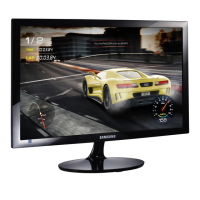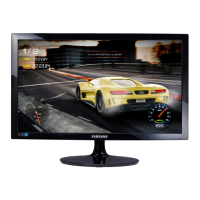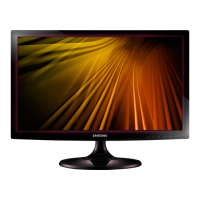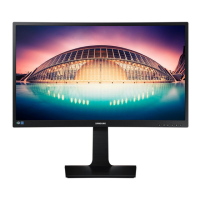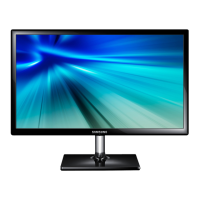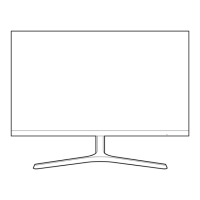
Do you have a question about the Samsung S24D590PL and is the answer not in the manual?
| Screen Size | 23.6 inches |
|---|---|
| Resolution | 1920 x 1080 |
| Panel Type | PLS |
| Brightness | 250 cd/m² |
| Contrast Ratio | 1000:1 |
| Dynamic Contrast Ratio | Mega ∞ DCR |
| Response Time | 5 ms |
| Viewing Angle | 178°/178° |
| Aspect Ratio | 16:9 |
| Refresh Rate | 60 Hz |
| Color Support | 16.7 million |
| Connectivity | HDMI |
| Weight | 3.9 kg |
Legal notice regarding manual content ownership and usage rights.
Explains symbols and icons used throughout the manual for clarity.
Step-by-step instructions for safely cleaning the monitor screen and exterior.
Specifies required clearance around the monitor for proper ventilation and heat dissipation.
Guidelines and recommendations for storing the monitor when not in use.
Essential safety warnings and guidelines to prevent injury and product damage.
Details the meaning of warning and caution symbols used in the manual.
Provides guidance on ergonomic setup for comfortable and healthy monitor usage.
Lists items included in the product package and how to verify them.
Identifies and describes the main physical components and ports of the monitor.
Explains the function and operation of the monitor's control panel and JOG button.
Details the shortcut functions accessible via the JOG button for quick adjustments.
Describes how to navigate and use the on-screen display (OSD) menu system.
Details the various input/output ports located on the back of the monitor.
Step-by-step instructions for attaching and detaching the monitor stand.
Explains how to adjust the screen tilt for optimal viewing.
Information on how to use an anti-theft locking device for security.
Important checks to perform before connecting any external source device to the monitor.
Guides on connecting the monitor to a computer using different cable types.
Instructions for connecting the monitor to a power source using adapters.
Procedures for installing monitor drivers for optimal performance and resolution.
How to configure the monitor and PC for the best possible screen resolution.
How to modify the screen brightness level for optimal viewing.
How to adjust the contrast between light and dark areas for clearer images.
Controls the clarity and definition of image outlines on the screen.
Optimizes screen settings specifically for playing video games.
Provides preset picture quality modes for various environments and content.
Enhances detail and vividness, particularly for lower-resolution content.
Adjusts the picture aspect ratio and scaling to fit the screen.
Optimizes HDMI picture quality by adjusting the black level for better contrast.
Controls panel response rate for smoother video playback and reduced motion blur.
Adjusts the horizontal and vertical positioning of the screen image.
Adjusts the screen frequency, primarily for analog signal inputs.
Fine-tunes the screen image for better clarity and vividness.
Modifies the intensity of the red color component in the picture.
Modifies the intensity of the green color component in the picture.
Modifies the intensity of the blue color component in the picture.
Adjusts the overall color temperature and tone of the displayed image.
Fine-tunes the mid-range brightness levels (grey scale) for better image contrast.
Allows selection of the OSD menu language for user interface.
Adjusts the horizontal and vertical position of the OSD menu on the screen.
Configures how long the OSD menu remains visible on the screen before automatically disappearing.
Adjusts the transparency level of the OSD menu windows.
Restores all monitor settings to their original factory default values.
Reduces power consumption by adjusting screen brightness and other power-saving features.
Configures the monitor to automatically turn off after a specified period of inactivity.
Selects the appropriate input mode (PC or AV) for optimal display settings.
Controls the response rate of monitor buttons when pressed repeatedly.
Configures how the monitor automatically detects and switches between input sources.
Manages the status indicator (LED) for power on and standby modes.
Shows current input source, resolution, and refresh rate of the monitor.
Allows direct adjustment of brightness and contrast from the initial screen.
Allows direct adjustment of audio volume from the initial screen (HDMI mode only).
Information about the Easy Setting Box software for screen partitioning.
Step-by-step guide for installing the Easy Setting Box software.
Instructions for uninstalling the Easy Setting Box software from the computer.
Recommendations for product testing and self-diagnosis before seeking customer support.
Guide for performing self-diagnosis tests to check product functionality.
Explains how to identify and resolve 'Not Optimum Mode' messages.
Addresses common problems related to monitor connection and setup with PCs.
Solutions for various screen problems like blank screen, distorted images, or blurriness.
Troubleshooting steps for problems related to audio output or lack of sound.
Guidance for resolving issues related to input source detection and connectivity.
Answers common user questions regarding monitor settings and adjustments.
Detailed technical specifications for the S24D590PL monitor model.
Detailed technical specifications for the S27D590P monitor model.
Information on the power-saving features and their energy consumption levels.
Lists supported resolutions and frequencies for optimal display compatibility.
Provides contact information for Samsung customer support in various regions globally.
Outlines conditions under which service charges may apply, even within warranty.
Guidelines for environmentally responsible disposal of the product and its electronic accessories.
Defines key technical terms and concepts used throughout the manual for better understanding.
